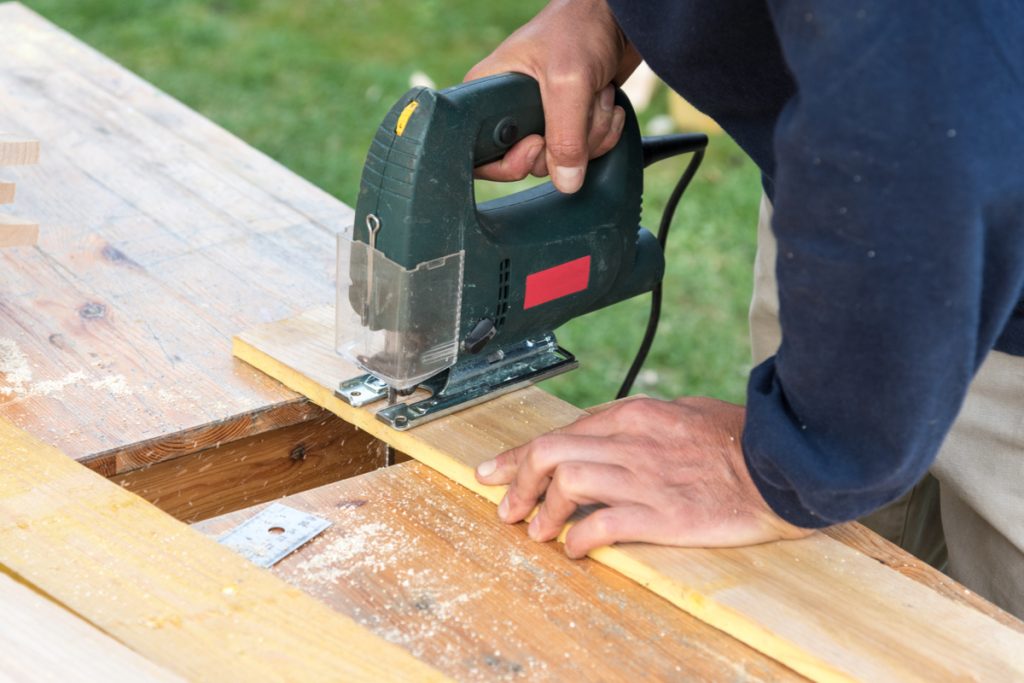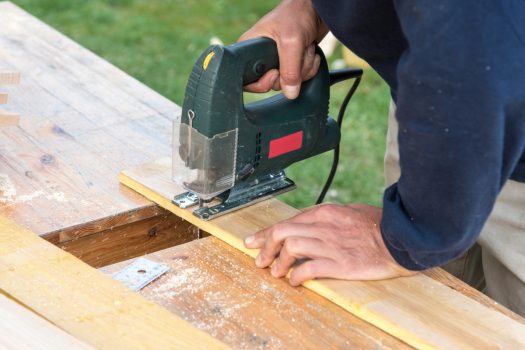Contents
Which is Better, Jigsaw or Reciprocating Saw?
This depends greatly on what you’re going to be using it for. If you want a saw that can be used anywhere and pretty much cut any material, the reciprocating saw is hard to beat.
However, jigsaws give the user much more control and are especially good for delicate work involving curves and unusual lines. This is presumably why they are called jigsaws because you could cut unusual bumps and shapes like if you were to make a jigsaw puzzle with one.
Generally, the two saws are quite similar in terms of the thickness and materials they can handle, but the key difference is in their flexibility and usage.
If you are doing a construction project and want something you can use above head level, on the ground or anywhere else to cut materials like wood easily then the reciprocating saw is ideal. If you want something for precision woodwork on a table or bench, then the jigsaw is for you.
Neither one is better than the other, but choosing one over the other will definitely depend on what you’re going to be using it for.

Are Jigsaws Easy To Use?
Most people find jigsaws easy enough to use, but if it’s your first time using one there are a couple of things you’ll need to know. Firstly jigsaws can be hard on the wrists compared to other types of saws.
They have a tendency to catch and can wrench the arm a bit if you aren’t expecting it. In terms of where to use it, you won’t be able to use it like you might a reciprocating or circular saw. You’ll need to use it on a stable surface such as a workbench.
Jigsaws can be used to cut straight lines, but they are also great for more intricate work and can accommodate smooth curves, bends, and angular work without much trouble.
Our advice to you is to practice on scrap wood first and keep a firm hand on whatever it is you’re cutting so it’s sandwiched between a sturdy surface and your palm.
Can I Use A Jigsaw Instead Of A Circular Saw?
A jigsaw can accomplish most of the tasks that a circular saw can, however, there are some key things to consider when you’re trying to decide which is best for a particular job.
Circular saws have a much more powerful, large blade. Like the name would suggest, a circular saw has a disc-shaped blade that revolves.
This makes it great for quickly cutting straight lines, but it is next to useless for dealing with complicated niche cuts because the blade is straight and wide. That’s where the jigsaw excels.
A jigsaw had a thin blade that cuts in an up-and-down motion which means it can easily handle curves and complicated shapes that you might find are needed in joinery, carpentry, or kitchen fitting.
You can also use a jigsaw for straight cuts like a circular saw, but the results tend to be a little less smooth and usually it takes longer to cut the same line with a jigsaw as it would with a circular saw. The answer to the question is, yes.
You can use a jigsaw instead of a circular saw, but it may not always be the better choice, depending on what the project is.
How Do You Cut Straight With A Jigsaw?
If you are just cutting a plank of wood in two with a straight line, draw the line with a ruler first on the rough side of the wood, place one end on the workbench with the cutting line a couple of inches off the edge of the bench.
If there is too much overhang off the bench then the wood will move too much when the saw starts and you will struggle to get a clean line, especially if it’s a pliable wood, so keep it as close to the table as you can without cutting into the workbench with the saw.
Stand so you are looking directly down the line with your dominant hand ready to operate the saw. Your other hand should be flush to the wood that is on the table, holding it steady.
This is really important because the saw is powerful and can easily catch on an imperfection in the wood and will both saw and wood may jerk if that happens. If the wood is not securely held flat then it may jerk up with the blade and possibly break.
Once you are confident that your left hand (or whichever is not your dominant hand) is leaning heavily on the part of the wood resting on the table, you should line up your jigsaw with the end of the line.
Double-check you are looking straight down on the line or it’s easy to go awry. Start the saw without pressing the blade to the wood and once it is on, start to cut.
Be confident when holding a jigsaw and engage your core, like you’re working out. It will help stabilize you and the saw because they do tend to judder quite a lot compared to circular saws.
Apply consistent and steady pressure to keep the jigsaw moving and check as you go that the blade is correctly lined up with the pencil line. The faster you can do it, the smoother it will be but do not apply too much force to the saw or the blade could break.
What Is The Thickest Piece Of Wood A Jigsaw Can Cut?
Jigsaws are generally better at handling softwood over hardwood, so you’ll need to make allowances for what a jigsaw can accomplish if you’re cutting oak, pine, or something similar.
f you are cutting hardwood, then it should be no more than three-quarters of an inch thick or the jigsaw may struggle. If you are sawing softwoods though, you should be fine to saw anything up to about an inch and a half thick.
Whatever type of wood you are cutting, resist the urge to force the saw through the wood as this is a sure way to end up snapping the blade or damaging the mechanism.
A jigsaw is not a circular saw so be patient with it. Also, make sure you have a good sharp blade before you start cutting anything towards the upper thickness we’ve suggested. That will make it a lot easier and give you better results.
Will A Jigsaw Cut Through Oak?
A Jigsaw can handle hardwoods such as oak, maple, cherry, hickory, or pine but these are harder for the jigsaw to get through. Certain allowances and considerations should be made when using a jigsaw to cut through hardwood.
You’ll need a good sharp blade for the job to start with and you’ll need to make sure the piece of oak is less than an inch thick. As a guide, we recommend that ¾ of an inch is the maximum thickness of hardwood you should try to saw with a jigsaw.
You should always cut with the rough side facing up towards you when using a jigsaw because they can splinter the wood as the blade moves upwards. The splinters won’t be big unless your blade is getting blunt in which case it’s a good indication that it is time to change it.
If the splinters are showing on the display side of whatever you’re sawing then it can look a little hastily done and that’s not what you want. For best results when cutting oak or any hardwood, try to keep the wood as still as you can to limit the movement of the actual wood.
The only thing you want to move is the saw itself while you’re cutting. This will help limit splintering too.
How Do You Use A Jigsaw Without A Table?
Most people find that using a solid workbench or a split bench gives the best results when cutting with a jigsaw. However, if you are using the tool at a site and not in your workshop then there are some tricks of the trade to help you cut with a jigsaw without a table or bench.
If you don’t have a table to hold the wood flat to, then you will need something else to steady it. When you’re cutting with a handsaw or jigsaw the only effective way to make a clean cut is to brace the wood or whatever you’re cutting to something secure that’s not going to budge.
If you tried to put a piece of wood on the ground and didn’t touch it with anything except the saw, the wood would likely move rather than be cut by the saw. It would just push away from you as you try to push the saw into it. If the wood moves, it’s not going to cut well.
If you have a long beam of inflexible wood, such as lumber or oak that you might find lying about if you’re working on a construction site, then propping one end of the beam onto something slightly off the floor, like a log or thick post, can give you purchase on the wood you wish to saw.
With one knee on the floor and your thigh braced against the beam, you can hold one end of the wood you’re going to cut on a flat side of the beam. Make sure where you’re going to be cutting is far enough from the beam underneath so you’re not going to damage it with the saw.
You operate the saw with your dominant hand but the other hand needs to press the cutting wood firmly to the beam. Imagine you are a bench clamp and think inflexible thoughts. The more the cutting wood moves, the harder it will be to get a neat cut, so hold the wood as steady as you can.
You can use any sturdy surface to cut wood on that is at least two inches off the ground. As long as something strong and unyielding is underneath the wood you are cutting and your hand is over the top of it, to restrict movement, you should have enough control over the cut.







